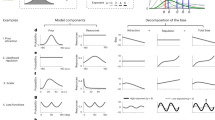Abstract
Ganz1 has suggested that figural distortions found with geometrical illusions are produced by lateral inhibition which results whenever the visual system signals information about spatially adjacent contours2. In explaining why two lines appear out of alignment when a further figure is next to one of the lines (Fig. 1) Ganz has assumed that apparent location is determined by the mean of the spatially distributed ridge of excitation which is the neural correlate of a contour. When one figure is near another the distribution of excitation from each figure is modified through lateral inhibition. Excitation is not, however, uniformly reduced ; the sections of a distribution which are closer to the peak of the excitatory ridge of the other figure are inhibited more than sections farther away. The mean of each distribution will thus be shifted, and the figures will appear displaced from each other.
This is a preview of subscription content, access via your institution
Access options
Subscribe to this journal
Receive 51 print issues and online access
$199.00 per year
only $3.90 per issue
Buy this article
- Purchase on Springer Link
- Instant access to full article PDF
Prices may be subject to local taxes which are calculated during checkout
Similar content being viewed by others
References
Ganz, L., Psychol. Rev., 73, 128 (1966).
Hartline, H. K., Ratliff, F., and Wagner, H. G., J. Gen. Physiol., 39, 651 (1956).
Gregory, A. H., Nature, 220, 827 (1968).
Ohwaki, S., Tohoku Psychol. Folio, 19, 30 (1960).
Springbett, B. M., Brit. J. Psychol., 52, 105 (1961).
Day, R. H., Percept. Motor Skills, 13, 247 (1961).
Schiller, P., and Wiener, M., Percept. Motor Skills, 15, 739 (1962).
Boring, E. G., Sci. Amer., 204, 18 (1961).
Oyama, T., Amer. J. Psychol., 75, 45 (1962).
Piaget, J., Les Mécanismes Perceptifs (Presses Universitaires de France, Paris, 1961).
Bates, M. A., Amer. J. Psychol., 34, 46 (1923).
Rudel, R. G., and Teuber, H.-L., Quart. J. Exp. Psychol., 15, 125 (1963).
Gregory, R. L., Eye and Brain (Weidenfeld and Nicolson, London, 1966).
Over, R., Psychol. Bull. (in the press).
Over, R., Nature, 214, 629 (1967).
Author information
Authors and Affiliations
Rights and permissions
About this article
Cite this article
OVER, R. Lateral Inhibition Explanation of Geometrical Illusions. Nature 222, 99–100 (1969). https://doi.org/10.1038/222099b0
Received:
Issue Date:
DOI: https://doi.org/10.1038/222099b0
Comments
By submitting a comment you agree to abide by our Terms and Community Guidelines. If you find something abusive or that does not comply with our terms or guidelines please flag it as inappropriate.



